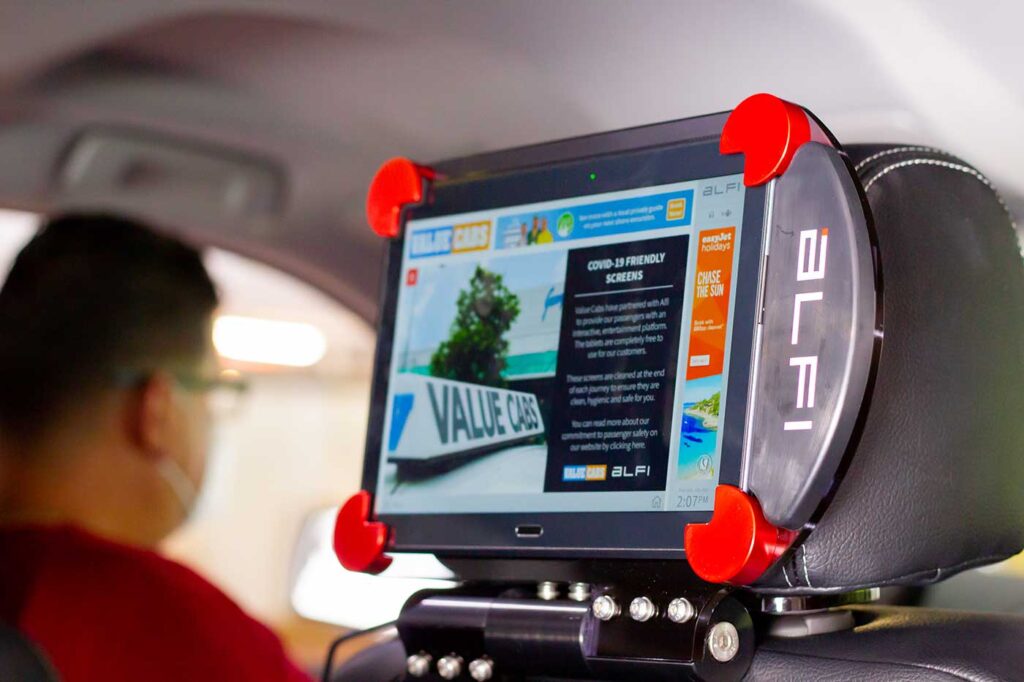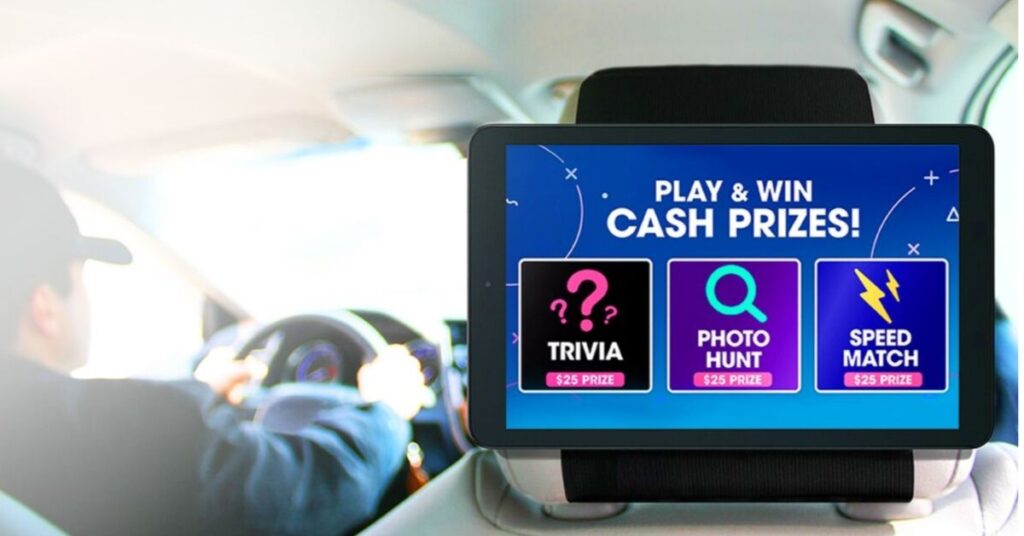As Uber and Lyft have become household names – and even action verbs – and other companies have attempted to compete, the rideshare industry has continued to grow by leaps and bounds without any sure signs of stopping.
Today, 12.5 million riders use the Lyft app each quarter and they currently hold a 32% market share in the US. 1.44 billion rides are completed through Uber every quarter.
In fact, Uber alone processed $26.61 billion in gross bookings from its ridesharing business in 2020. Lyft is predicted to process $12.93 billion worth of rides in the US in 2021, an increase of 8.2% compared to 2019, the last full pre-pandemic year.
With numbers like these, it’s clear that it’s time to consider rideshare advertising.
You might be wondering what exactly rideshare advertising entails. Does it mean brands advertise on rideshare smartphone apps or are the ads inside the vehicles themselves? How does it work? Let’s break it down.
What is rideshare advertising?
While rideshare advertising might sound confusing, it’s actually a pretty straightforward process. Rideshare advertising is the process of displaying advertisements inside or on Uber, Lyft, and other vehicles used for transporting passengers.
Read on to learn everything you need to know about rideshare advertising in this post including:
- Rideshare Advertising in Uber and Lyft Cars
- Rideshare Accessories for Advertising
- Best Rideshare Advertising Companies
Let’s explore how rideshare advertising benefits everyone involved, including companies, brands, and drivers alike.
Rideshare Advertising in Uber and Lyft Cars
The added convenience of user-friendly tech and apps has spawned a thriving rideshare industry. With the simple click of a button, people can order a vehicle to whisk them away with ease.
A form of DOOH (digital out-of-home) advertising, rideshare advertising displays ads inside of or on Uber, Lyft, and other vehicles. These highly relevant ads can even provide solutions for problems that passengers might have.
Advertisers love it as it provides the perfect opportunity to address potential customers en route to their next destination. Brands enjoy the benefit of having a rider’s full attention in the back of a vehicle. With the average Uber ride clocking in at 5.41 miles, there is ample time to engage passengers and connect them to relevant products and services.
Brands are not the only ones benefiting from rideshare advertising, however. Uber and Lyft drivers also earn revenue while they run ads. That money comes in handy when you consider that their earnings are dwindling – factoring in all costs involved – and the benefits are slim to none.
Drivers for Uber and Lyf in 2017 made 53% less than they did in 2013. In 2018, the median wage for Uber drivers clocked in at $9.21 after expenses. In 2021, this has still not drastically improved, though things have improved considerably.
“In Seattle, which in January [2021] implemented the city’s minimum wage of $16.39 per hour for ride-hail drivers, a city-commissioned study found drivers net only about $9.70 an hour, while a study of data provided by Uber and Lyft showed most drivers’ earnings are roughly in line with the city’s median.” – Reuters
It’s hard to live on inconsistent wages – that in many places pay less than $10 an hour – so it makes sense why many drivers are turning to ads to supplement their income.
Leveraging Rideshare Accessories
With rideshare advertising, content and ads are delivered via rideshare accessories located inside or displayed outside on the vehicle. While both are viable options, in-vehicle advertising is quickly gaining popularity thanks to the detailed targeting options offered by companies like ALFI with the help of artificial intelligence and machine learning.
Beyond advertising to people passing by, in-vehicle advertising gives marketers access to a captivated audience for the duration of each ride.
There are numerous options for rideshare accessories out there, with some more popular and effective than others. Let’s explore a few of them.
Interactive Tablets
As popular as smartphones and touchscreens are, it’s no wonder that interactive tablets are quickly becoming the most popular way to deliver rideshare ads to passengers. Once installed in the vehicle, the tablet provides curated entertainment and ads for an enhanced rider experience. Entertainment options might include games, news, movie trailers, and more.
Interactive tablets generally target people in one of two ways: location-based interactive tablets and/or machine-learning tablets.
As their name suggests, location-based interactive tablets deliver ads based on the location of the vehicle. For instance, if the driver is delivering a passenger to a designated shopping area, the ads could be related to promotions specific to retail stores in that locale. If the driver is headed to a residential area, food delivery ads might pop up to pique the interest of potentially hungry passengers.
Other tablets employ powerful machine-learning to determine more information about who is riding in the vehicle. Marketing ads are then targeted based on actual passenger info rather than by location. These ads can be chosen based on age, gender, mood, and more. Ads powered by machine-learning are much more targeted – and can be far more effective – than location-based ads.
Powerful AdTech company, ALFI uses computer vision and machine-learning models to identify the demographics of the person looking at the tablet screen and then deliver personalized content along with advertisements. Delivering relevant, strategic content results in higher than industry average click-through rates and better return on investment for advertisers.
LED Billboards
Another useful, engaging accessory for rideshare advertising is the LED billboard. Instead of advertising solely to passengers inside of the Uber or Lyft vehicle, LED billboards are installed on top of the rideshare vehicles. There, the content and ads can be viewed by each person the vehicle passes: drivers, passengers, and pedestrians alike. Plus, riders will also be exposed to this content as they enter and exit the rideshare vehicle.
In addition to advertising for companies, LED billboards are often used to relay civic messages to people in the city and can even be used to collect data regarding temperature and pollution.
Car Wraps
Another rideshare accessory for advertising on Lyft and Uber vehicles is the car wrap. Sponsoring companies and brands choose the design and create the wrap. Then, the driver wraps the advertisement around the vehicle, using it as a mobile billboard that is visible to people in nearby vehicles.
As might be expected, Uber and Lyft don’t really want their drivers to use car wraps to make extra money. However, these companies don’t actively do anything to prevent it, so drivers are still allowed to use this marketing method. They do need to update their profiles in the apps so people can find them.
When considering using a car wrap on your vehicle, there are two things to bear in mind. Adding a car wrap could potentially cause you to lose some business with Uber and Lyft because your vehicle won’t appear as professional or appealing. Another, more serious issue is that car wrap scams have become a real problem. It’s gotten so bad that the Federal Trade Commission posted information on how to spot a car wrap scam. So when considering a car wrap, be selective in your vetting process.
Phone Apps
The ability to hail rides is only one function of smartphones. Now, phone apps can also be used for rideshare advertising. While many different options exist, advertising apps that play music are extremely popular at the moment and offer broad audiences for targeting.
Companies and brands can create campaigns and advertise on these apps; as long as the drivers play the music – and ads – while they work, they’ll receive compensation. Drivers give passengers the music they want; brands connect with the target audience they seek. It’s a win-win situation for all involved. Music apps are just one example; there are plenty more options to choose from.
Best Rideshare Advertising Companies
With so many rideshare advertising companies out there, it’s important to be careful when selecting one. Choose an advertising company that will get you the results you’re seeking.
If you’re a rideshare driver, that means choosing a company with the best payouts. If you’re a marketer, that means selecting a company with targeted ads that will reach the right audience and deliver the best return on investment.
Let’s review the top advertising companies out there both for drivers and marketers. These companies made our list because they stand out from the rest in one aspect or another.
ALFI

While other platforms blur the line when it comes to user privacy, ALFI is building the future of DOOH advertising by crafting tools that empower media buyers to reach their exact target market, at the right time, for a fraction of the cost. And in a respectful and ethical manner.
ALFI is quickly rising to the top of rideshare advertising companies. Using computer vision and machine learning models, ALFI offers advertisers more effective targeting options.
The genius of Alfi is behind its AI, machine learning, and computer vision models. For the first time, audiences can be targeted in real-time based on their behavior and physical demographics. Brands can now determine how effective their OOH ad is at getting attention, but also collect valuable audience data to get true insight on who is paying attention.
While it sets new standards by providing precise targeting information to advertisers, it does so without intruding by collecting information in non-intrusive ways that are compliant with GDPR, CCPA, and HIPAA.
Once it determines who is in the vehicle, it can provide the right type of content. This innovative technology can offer relevant places of interest, local attractions, news stories, interactive surveys, traffic alerts, and movie trailers. Passengers can even play games using ALFI.
Without having to input or store any personal information, ALFI provides advertisers with access to detailed targeting options, in-depth analytics, and instant access to update and improve their campaigns in real-time.
Advertisers aren’t the only ones who benefit from ALFI. Their outstanding compensation program allows drivers to earn up to $696 a month.
Play Octopus

Another option is Play Octopus, a bar-trivia gaming tablet. This technology allows advertisers to change content or increase ad frequency based on a particular vehicle’s location. Passengers are given the option to create an account or enter information into the tablet. Play Octopus then delivers response-based analytics to advertisers.
Because the ads displayed are geotargeted, they are not as effective, as they don’t resonate with all passengers. Plus, the driver compensation is not as good as other rideshare advertising options.
Vugo

Vugo is another tablet-based rideshare advertising option that uses geotargeting when serving ads. People are served ads that are chosen based on their location rather than their identity. This means that passengers end up seeing a variety of ads that aren’t relevant or interesting to them.
This problem impacts marketers, but it does not stop there. Drivers are negatively affected because the compensation structure is based on passenger interaction. The more that people interact with the ads, the more revenue drivers make. If passengers aren’t interested in the ads, then they won’t interact with them, so drivers might not make enough to pad their paychecks.
VIEWDIFY
Like ALFI and the other rideshare advertising companies, VIEWDIFY combines entertainment and advertisements. The company mainly offers advertising options in major cities, using geotargeting to display relevant content.
In general, their ads are targeted towards young and influential people with money to burn. That makes sense considering that analysis suggests the average 20-something will spend $323,190 on Uber rides over the course of 25 years. It’s clear that many rideshare passengers do have disposable income. According to VIEWDIFY, drivers can make over $100 a month by adding a tablet inside their vehicles.
Brian Petterson
Lead audience developer, manager. Passionate about all things digital media, marketing, social marketing, content marketing, and innovation. My passion is adventure.

